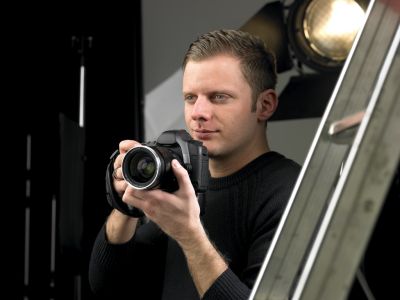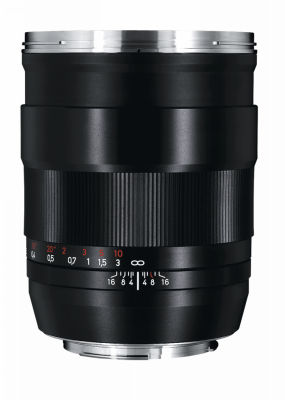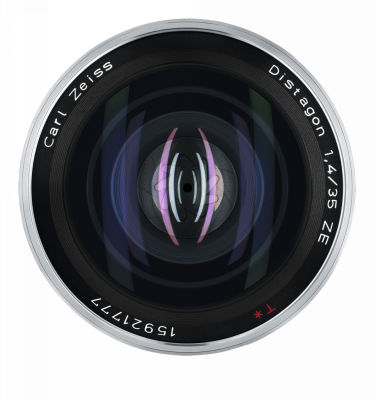The fast all-around talent – BROCHURE CAN BE DOWNLOADED HERE
Carl Zeiss presents a new moderate wide-angle lens
OBERKOCHEN, September 1, 2010 – A woman is sitting at the bar of a dimly-lit cafe. Lost in thoughts, she doesn’t notice the glass of wine the bartender places before her. From a distance, a photographer tries to capture her mood. He brings her face, which is leaning toward her phone, into focus. Everything around her becomes a blur, and the lights in the background coalesce into a wild “dance” of diffuse shapes.
This shot will only work with a fast lens with short focal length and harmonious bokeh. Carl Zeiss introduces a new lens for just such images: the Distagon T* 1,4/35.
By introducing the Distagon T* 1,4/35, Carl Zeiss is complementing the Planar T*1,.4/50 and T*1,4/85 lenses with a wide-angle lens that shares the same high speed. Crisp, sharp images work every time, whether at dusk or in the weak lighting conditions of a café, and without the need for a tripod. With its 35-mm, the Distagon T* 1,4/35 matches the classic and versatile standard focal lengths when used on cameras with APS-C sensor formats.
Due to the special bokeh effects in both the foreground and background areas, the Distagon T*1,4/35 opens up new creative possibilities, giving photographers more options to ‘play’ with focus. Thanks to its large focus ring, photographers can also create highly accurate, sharp pictures, even at maximum aperture opening. This also makes the lens an ideal addition to the filmmaker using DSLR’s for HD video capture. In addition, the optical construction of the lens guarantees high image quality across the entire image range. Furthermore, with one step less than the full aperture opening, the light fall-off toward the edges is just one f-stop.
With the ZEISS T* anti-reflective coating, its sophisticated stray light reduction and the excellent flare control, the new Distagon also takes pictures of bright light sources without artifacts. The Distagon T*1,4/35’s extremely long-lasting and robust all-metal precision mechanics, for which Carl Zeiss is known, make this lens perfect for use on-the-go and for photo reports.
The Distagon T* 1,4/35 will be available in first quarter of 2011 at a recommended retail price of $1,843 USD.
Technical specifications
Focal length 35 mm
Aperture range f/1.4 – f/16
Number of elements/groups 11/9
Focusing area 0.3 m – infinity
Angular field** (diag./horiz./vert.) 63/54/37 °
Coverage at close range 18 x 12 cm (close-up)
Image ratio at close range 1:5 (close-up)
Filter thread M 72 x 0.75
Weight 830 – 850 g
Length with caps 120 – 122 mm
Diameter 78 mm
Mounts ZF.2 (F bayonet)
ZE (EF bayonet)
* As of September 01, 2010
** relates to small camera format




Nice but to BIG for manual focus lens… at least on F5/D3s
even with those beautiful and smooth transitions.
I am very very satisfied with my new Nikon 35 f1,4 G lens
It renders OOA in a very pleasing way…
And its sharp W/O!
And it is manual focus :)))
Hmm interesting. I was thinking about the ZF 50 last night – the older ones as I don’t need the cpu crap for my FM3a.
The problem with this lens is the size! I’d love and AFS 35/2 for my F80’s – but for my fm3a I am now looking at the voigtlander 40/2 Asph that get rave reviews too…. and is MUCH smaller. F2 is plenty wide for selective focus and 1.4 just starts to look a bit gimmicky IMHO.
Ha ha! Good point! At this moment I’m staring at my FM2 with f2.0/35 Ai-s Nikkor, side by side with my D700 with f2.0/35 ZF.2 Zeiss (which almost looks like an 85 😉 ), and wonder what caused the glass to grow…
The Zeiss is a much better lens of course, but the Nikkor is fine for b&w.
I’m staying with my FM3a and CV 40 pancake. That Zeiss is too damn big.
I really wish I could find some info on how well these lenses work with the 7D. The 50 f/1.4 has been on my wishlist for some time, but I have no idea if it is possible to accurately focus such a lens on the 7D.
Why not if it’s possible (I’ve got the 2.0/35, 1.4/50 and 1.4/85) with the D700? It does take some getting used to, you have to make a bit of an effort, in an era of autofocus. Some users get a Catseye focusing scree to help them.
Thanks! I find it hard to see whether comments about difficult manual focus on the 7D are because it is truely difficult or just because people fail to put in the effort to learn. It makes sense though that if it works on the Nikon bodies with a similar focusing screen, that it should also work on the 7D.
The Catseye screens are very interesting. I just don’t know if I would be comfortable with changing a screen that is not meant to be changed.
@Dutch: how about a three step plan:
1 Try 7D and 35mm out in a shop and as far outside the shop as they will let you wander.
2 If that is not a put-off, buy lens.
3 I (not knowing the 7D’s screen however) would be surprised if you would feel the need for a Catseye. I got used to focusing manually with the D700 pretty quickly (but I’m an old guy; I grew up in an MF world). Yes, sometimes focus is missed, particularly at large lens openings and with fast moving subjects. Makes life more interesting.
Thanks for the advise! I will see if I can find a way to test the lens in a variety of circumstances before I buy, so I can get a decent feel for focusing.
Pretty but the legendary Zeiss F2 stays on my to get list, since its manual focus only I wouldnt want to use it at 1.4 much , f2 is already cutting it.
Is there any chance of Zeiss releasing an M mount 35 1.4 at photokina?
Look at the size of that thing! I’m keeping my new 35 lux:)
Maybe it’s a small guy, making the whole thing looking twice as big… 🙂
I also want some of the weed that guy just smoked.
RB
That is funny, Robert! He does look a little cooked 🙂 or maybe there is a completely naked beauty on the other side.
Now you know what Zeiss was talking about when they said Holo-gon. it’s german for Hallu-gon.
RB
Steve,
Don’t know about the lens but I want that generic plato-blob camera it’s attached to in a big big way. Can I use one of your aff links to get it?
RB
😉
Actually looks like a Canon to me. I have kitted out my D700 with the same strips of black masking tape, in a vain, very vain, attempt to disguise and anonymize the camera… 🙂
Michiel,
Yea – I’ll bet you your D700 now looks like an M or something. Maybe you should try putting in in an old lunch box or something with some sort of holes cut into it?
Actually I had to comment on that image at the top – Ask yourself this: What is that image for? Why would someone create that image – it’s a stupid image in every single way. It’s on a spec sheet somewhere – that’s why.
1) Product shots.
2) Image of guy with generic plastic blob and new lens, make sure the guy isn’t too active, kinda make him look satisfied but not too too happy, he can’t look crazy, and make him look sly, make sure he is not actually shooting anything because whatever he might be shooting could offend someone, don’t make him too good looking, etc. – see this is the image that is supposed to say “Hey that could be me with that spiffy new lens” Stupid.
I am overly sensitive to really bad purposeless cannon fodder images that have to be done because they are on the spec sheet. Once someone somewhere get’s it on that sheet the ridiculous “art” director in charge will make sure you shoot it with his own judgement on what the specs mean (usually a too the letter but not the spirt).
Holy crap flash backs to my days as a commercial shooter. ohhhhh noooo.
RB
Robert I get your drift. The spiel on the scene being captured is actually promising, but the execution of the marketing idea, photograph included, is almost painfully bad. Comforting thought that that probably doesn’t affect the quality of the lens, ha ha.
And yes, I have disguised my D700 to resemble a Leica M3 in the smallest detail, and it works! 🙂
That’s annoyingly tempting (I’ve got the f2.0/35 ZF.2 on the D700, and that is one stellar piece(s) of glass)…. 🙁